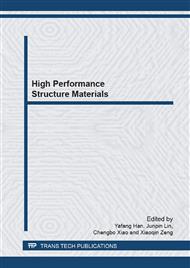p.115
p.124
p.132
p.139
p.146
p.152
p.158
p.166
p.172
A Study of Laser Cladding on the NiCr/Cr3C2-WS2-CaF2 Coating
Abstract:
NiCr/Cr3C2-WS2-CaF2 mixed powders were prepared on 1Cr18Ni9Ti stainless steel substrate to fabricate high-temperature self-lubrication wear resistant composite coating by laser cladding. The microstructure of the coating was examined by means of XRD, SEM and EDS. The high-temperature dry sliding friction and wear behavior of the composite coating were evaluated by using a ball-on-block wear tester at room temperature, 300 and 600 , respectively. The results showed that the composite coating had a unique microstructure consisting of γ-(Ni,Fe) solid solution matrix, Cr7C3/WC reinforcement and CrS/WS2 lubricant particles. The hardness of NiCr/Cr3C2-WS2-CaF2 coating by laser cladding was lower than NiCr/Cr3C2 coating, but higher than stainless steel substrate significantly. It was because of the addition of solid lubricant. In the wear process, elevated temperature was helpful to form a lubricating transfer film. As a result, the NiCr/Cr3C2-WS2-CaF2 coating exhibited a notable anti-friction and wear resistance at 300 and 600 .
Info:
Periodical:
Pages:
146-151
Citation:
Online since:
February 2013
Authors:
Price:
Сopyright:
© 2013 Trans Tech Publications Ltd. All Rights Reserved
Share:
Citation:


